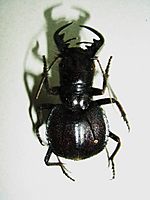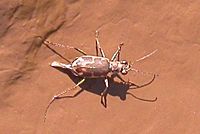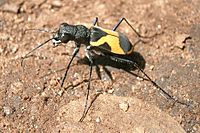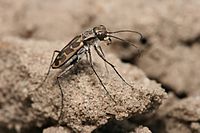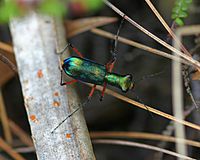Tiger beetle facts for kids
Quick facts for kids Tiger beetle |
|
|---|---|
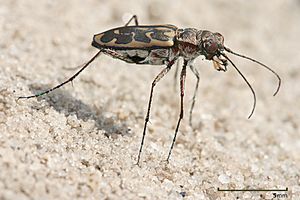 |
|
| Lophyra sp in Tanzania | |
| Scientific classification |
|
| Kingdom: | Animalia |
| Phylum: | Arthropoda |
| Class: | Insecta |
| Order: | Coleoptera |
| Superfamily: | Caraboidea |
| Family: | Cicindelidae Latreille, 1802 |
| Tribes | |
|
|
| Synonyms | |
|
|
Tiger beetles are a family of beetles, Cicindelidae, known for their aggressive predatory habits and running speed. The fastest known species of tiger beetle, Rivacindela hudsoni, can run at a speed of 9 km/h (5.6 mph; 2.5 m/s), or about 125 body lengths per second. As of 2005, about 2,600 species and subspecies were known, with the richest diversity in the Oriental (Indo-Malayan) region, followed by the Neotropics. While historically treated as a subfamily of ground beetles (Carabidae) under the name Cicindelinae, several studies since 2020 indicated that they should be treated as a family, the Cicindelidae, which are a sister group to Carabidae within the Adephaga.
Description
Tiger beetles often have large bulging eyes, long, slender legs and large curved mandibles. All are predatory, both as adults and as larvae. The genus Cicindela has a cosmopolitan distribution. Other well-known genera include Tetracha, Omus, Amblycheila and Manticora. While members of the genus Cicindela are usually diurnal and may be out on the hottest days, Tetracha, Omus, Amblycheila and Manticora are all nocturnal. Both Cicindela and Tetracha are often brightly colored, while the other genera mentioned are usually uniform black in color. Tiger beetles in the genus Manticora are the largest in size of the family. These live primarily in the dry regions of southern Africa.
The larvae of tiger beetles live in cylindrical burrows as much as a meter deep. They are large-headed, hump-backed grubs and use their humpbacks to flip backwards, for the purpose of capturing prey insects that wander over the ground. The fast-moving adults run down their prey and are extremely fast on the wing, their reaction times being of the same order as that of common houseflies. Some tiger beetles in the tropics are arboreal, but most run on the surface of the ground. They live along sea and lake shores, on sand dunes, around playa lakebeds and on clay banks or woodland paths, being particularly fond of sandy surfaces.
Tiger beetles are considered a good indicator species and have been used in ecological studies on biodiversity. Several species of wingless parasitic wasps in the genus Methocha (family Thynnidae), lay their eggs on larvae of various Cicindela spp., such as Cicindela dorsalis.
Adaptations
Tiger beetles display an unusual form of pursuit in which they alternatively sprint quickly toward their prey, then stop and visually reorient. This may be because while running, the beetle is moving too fast for its visual system to accurately process images. To avoid obstacles while running they hold their antennae rigidly and directly in front of them to mechanically sense their environment. There are many tiger beetles that hunt in flat, sandy areas, and their eyes have flat-world adaptations, such as high-acuity perception streaks corresponding to the horizon. A tiger beetle uses the elevation of its potential prey in its visual field to determine how far away it is. As visual hunters, tiger beetles tend to hunt in open, relatively flat habitats, such as sand bars, woodland paths, and barren ground scrubland. In this sense, beetles might be expected to use elevation as a distance cue in their visual pursuit of prey.
Fossil record
The oldest fossil tiger beetle yet found, Cretotetracha grandis, comes from the Yixian Formation in Inner Mongolia, China, and dates to the early Cretaceous Period, 125 million years ago. Most fossils found are grey or yellow silty mudstone. Traits that identify Cretotetracha as Cicindelinae include long mandibles shaped like sickles, simple teeth arranged along the mandible's inner surface, antennae that attach to the head between the base of the mandibles and the eye. The left mandible is approximately 3.3 mm and the right mandible is approximately 4.2mm long. A long body form roughly around 8.1mm where the combined eyes and head are wider than the thorax, and long running legs. Previously known Mesozoic fossils of tiger beetles have been described from the Crato Formation, about 113 million years ago and Oxycheilopsis cretacicus from the Santana Formation, 112 million years ago, both in Brazil.
Taxonomy
Tiger beetles had been treated either as a family Cicindelidae or as the subfamily Cicindelinae of the Carabidae (ground beetles) but since 2020, there has been growing evidence for the treatment as a separate family, that is sister to the Carabidae. Many genera are the result of the splitting of the large genus Cicindela, and many were described by the German entomologist Walther Horn.
-
Museum specimen of Manticora sp. from Mozambique.
-
The rare Salt Creek tiger beetle, Cicindela nevadica lincolniana
-
Cicindela goryi from India, showing the large eyes and mandibles
Genera
- Abroscelis Hope, 1838
- Amblycheila Say, 1829
- Aniara Hope, 1838
- Antennaria Dokhtouroff, 1883
- Apteroessa Hope, 1838
- Archidela Rivalier, 1963
- Baloghiella Mandl, 1981
- Bennigsenium W. Horn, 1897
- Brasiella Rivalier, 1954
- Caledonica Chaudoir, 1860
- Caledonomorpha W. Horn, 1897
- Callidema Guerin-Meneville, 1843
- Callytron Gistl, 1848
- Calomera Motschulsky, 1862
- Calyptoglossa Jeannel, 1946
- Cenothyla Rivalier, 1969
- Cephalota Dokhtouroff, 1883
- Chaetodera Jeannel, 1946
- Cheilonycha Lacordaire, 1843
- Cheiloxya Guerin-Meneville, 1855
- Cicindela Linnaeus, 1758
- Collyris Fabricius, 1801
- Cratohaerea Chaudoir, 1850
- †Cretotetracha Zhao et al., 2019
- Ctenostoma Klug, 1821
- Cylindera Westwood, 1831
- Darlingtonica Cassola, 1986
- Derocrania Chaudoir, 1860
- Diastrophella Rivalier, 1957
- Dilatotarsa Dokhtouroff, 1882
- Distipsidera Westwood, 1837
- Dromica Dejean, 1826
- Dromicoida Werner, 1995
- Dromochorus Guerin-Meneville, 1845
- Ellipsoptera Dokhtouroff, 1883
- Enantiola Rivalier, 1961
- Eunota Rivalier, 1954
- Euprosopus Dejean, 1825
- Euryarthron Guerin-Meneville, 1849
- Eurymorpha Hope, 1838
- Euzona Rivalier, 1963
- Grammognatha Motschulsky, 1850
- Grandopronotalia W. Horn, 1936
- Guineica Rivalier, 1963
- Habrodera Motschulsky, 1862
- Habroscelimorpha Dokhtouroff, 1883
- Heptodonta Hope, 1838
- Hypaetha Leconte, 1860
- †Hujia Song, Jarzembowski and Xiao, 2022
- Iresia Dejean, 1831
- Jansenia Chaudoir, 1865
- Langea W. Horn, 1901
- Leptognatha Rivalier, 1963
- Lophyra Motschulsky, 1859
- Macfarlandia Sumlin, 1981
- Manautea Deuve, 2006
- Mantica Kolbe, 1896
- Manticora Fabricius, 1781
- Megacephala Latreille, 1802
- Megalomma Westwood, 1842
- Metriocheila Thomson, 1857
- Micromentignatha Sumlin, 1981
- Microthylax Rivalier, 1954
- Myriochila Motschulsky, 1862
- Naviauxella Cassola, 1988
- Neochila Basilewsky, 1953
- Neocicindela Rivalier, 1963
- Neocollyris W. Horn, 1901
- Neolaphyra Bedel, 1895
- Nickerlea W. Horn, 1899
- Notospira Rivalier, 1961
- Odontocheila Laporte, 1834
- Omus Eschscholtz, 1829
- Opilidia Rivalier, 1954
- Opisthencentrus W. Horn, 1893
- Orthocindela Rivalier, 1972
- Oxycheila Dejean, 1825
- †Oxycheilopsis Cassola & Werner, 2004
- Oxygonia Mannerheim, 1837
- Oxygoniola W. Horn, 1892
- Paraphysodeutera J. Moravec, 2002
- Pentacomia Bates, 1872
- Peridexia Chaudoir, 1860
- Phaeoxantha Chaudoir, 1850
- Phyllodroma Lacordaire, 1843
- Physodeutera Lacordaire, 1843
- Picnochile Motschulsky, 1856
- Platychile Macleay, 1825
- Pogonostoma Klug, 1835
- Polyrhanis Rivalier, 1963
- Pometon Fleutiaux, 1899
- Prepusa Chaudoir, 1850
- Probstia Cassola, 2002
- Pronyssa Bates, 1874
- Pronyssiformia W. Horn, 1929
- Prothyma Hope, 1838
- Prothymidia Rivalier, 1957
- Protocollyris Mandl, 1975
- Pseudotetracha Fleutiaux, 1894
- Pseudoxycheila Guerin-Meneville, 1839
- Rhysopleura Sloane, 1906
- Rhytidophaena Bates, 1891
- Rivacindela Nidek, 1973
- Ronhuberia J. Moravec & Kudrna, 2002
- Salpingophora Rivalier, 1950
- Socotrana Cassola & Wranik, 1998
- Stenocosmia Rivalier, 1965
- Sumlinia Cassola & Werner, 2001
- Tetracha Hope, 1838
- Therates Latreille, 1816
- Thopeutica Schaum, 1861
- Tricondyla Latreille, 1822
- Vata Fauvel, 1903
- Waltherhornia Olsoufieff, 1934
See also
 In Spanish: Cicindelinos para niños
In Spanish: Cicindelinos para niños


